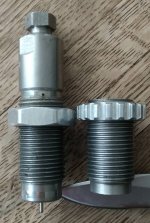I’m looking for some advice for some heavy bolt lift and extraction issues in a new barrel using brass previously fired from my old barrel. Based on all my testing and research thus far I’m thinking a small base die might be the answer to keep this brass going?
I’m getting a click at the top of the heavy bolt lift and after 3-4 shots the brass won’t extract. I have to get it out with a cleaning rod. I just got some 1x fired Lapua brass and it appears to be fine when checking it in the chamber after resizing. Here is a video.
I have always full length resized with a Redding Type S die. I'm certain the shoulder is bumping .002-.003. I have even tried bumping the shoulder back .005 and still experience the same problems.
I don't think the issue is over pressure. I'm running 42.0 H4350gr with 130gr ELD-Ms seating .020 off the lands. Here is a pic of some fired cases.

It looks like I'm getting some significant friction near the case head trying to extract the brass.

I’m getting a click at the top of the heavy bolt lift and after 3-4 shots the brass won’t extract. I have to get it out with a cleaning rod. I just got some 1x fired Lapua brass and it appears to be fine when checking it in the chamber after resizing. Here is a video.
I have always full length resized with a Redding Type S die. I'm certain the shoulder is bumping .002-.003. I have even tried bumping the shoulder back .005 and still experience the same problems.
I don't think the issue is over pressure. I'm running 42.0 H4350gr with 130gr ELD-Ms seating .020 off the lands. Here is a pic of some fired cases.

It looks like I'm getting some significant friction near the case head trying to extract the brass.

Last edited:






